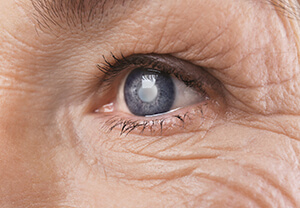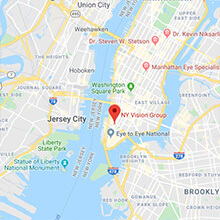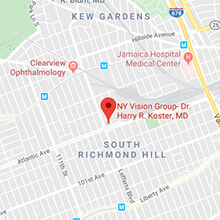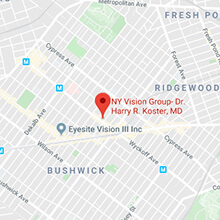Cataract Surgery in Brooklyn
Your vision with cataracts is similar to looking through a fogged-up window or dirty car windshield — cataracts can make it difficult to read, drive a car, watch TV, or recognize faces. Even when you can make things out, the quality of your vision is inferior.
When cataracts start to affect your ability to perform daily tasks, it may be time to consider cataract surgery. Cataract surgery can improve your vision. lessen your dependence on glasses, and significantly improve your quality of life.
Cataract surgery has undergone numerous advances in the last decade, shortening both the procedure time and the recovery time. New lens implants such as the PanOptix, Vivity and PanOptix Toric are now available, as is an innovative measurement system called the ORA. Patients may also opt to have FEMTO laser-assisted surgery.
What is a cataract?
A cataract is a condition in which the natural, clear lens of the eye hardens and slowly becomes hazy. The lens of the eye is located directly behind the iris. It is the shape of an M&M candy, with a clear lens encapsulated in a thin, clear bag. The lens helps to focus incoming light onto the retina and helps us see clearly at near distances. When a cataract occurs, near vision is lost without glasses, and the haze decreases the quality and quantity of vision, even with glasses.
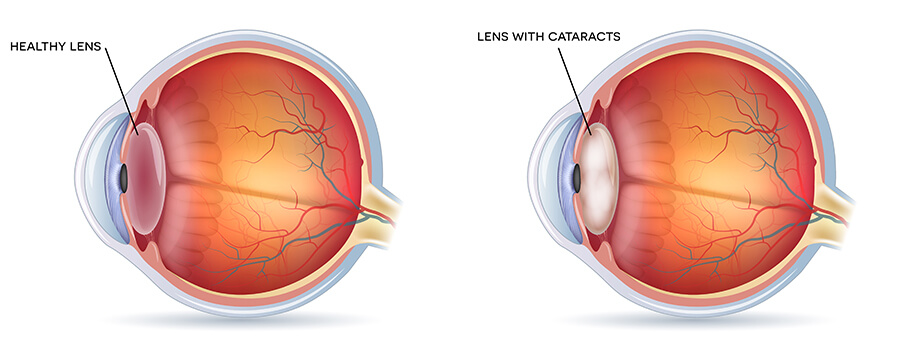
What causes cataracts?
Cataracts most often occur as a natural part of the aging process. A cataract can take years to develop — most people don’t notice the vision loss until after age 60. Additionally, several risk factors may accelerate the process, including a family history of cataracts; diabetes; eye injuries; eye surgery; or trauma to the eye; overexposure to sunlight; extended use of corticosteroids; smoking; and alcohol abuse.
What are the symptoms of cataracts?
Common signs of cataracts generally include:
- Poor up-close vision
- Blurry vision
- Double vision
- Glare or sensitivity to light
- Poor night vision (difficulty driving at night)
- Faded or muted colors
Can I prevent cataracts?
While it’s not possible to prevent a cataract from forming, there are steps you can take to reduce your risk:
- If you’re over age 65, schedule a comprehensive eye exam with dilation every year.
- Wear UV-resistant sunglasses to protect the eyes from sun damage.
- Make sure you have an up-to-date prescription for your glasses or contacts.
- Don’t smoke.
- If you have diabetes, carefully maintain good blood sugar levels.
How do you treat cataracts?
In the early stages of cataract development, eyeglasses and brighter lighting may help lessen vision problems caused by cataracts. As they progress, however, the most effective way to treat cataracts is with cataract surgery, one of the safest and most common surgeries available today. During the surgery, the patient’s clouded lens will be replaced with a customized artificial lens implant known as an intraocular lens (IOL). Traditionally this lens was able to correct vision at only one point, either near or far. Now, however, new lens technologies such as the PanOptix, Vivity, ReSTOR or Tecnis Symfony premium lenses, offer patients a wider range of vision choices and less spectacle dependence.
What happens during cataract surgery?
Prior to the cataract procedure, a patient with a cataract is evaluated to determine if they have any other eye conditions that could limit results. In addition, extensive measurements are taken to determine the appropriate lens and lens/IOL power.
Choice of Lens:
Next, a formal evaluation of the patient’s visual needs and goals occurs. Based on the exam findings, eye measurements, and the patient’s goals, a decision is made on the best implant for that patient, which may include implants that correct somewhat for distance (monofocals), or higher technology implants that correct for astigmatism (Toric) or near and far vision (PanOptix, Vivity, Tecnis Symfony or ReSTOR multifocal). Most patients who choose higher technology lenses are glasses-free for most of the day.
Choice of Cataract Removal Method:
Patients have the option of having FEMTO-laser-assisted cataract surgery (FLACS), in which a blade-free laser is used to make all incisions, correct astigmatism, and soften the cataract before removal. This is paired with a real-time, intra-operative measurement system, the Optiwave Refractive Analysis (ORA) during the procedure. ORA measurements are taken after the cataract is removed, but before a new lens is implanted, allowing adjustments to the IOL power if necessary.
During the actual cataract procedure, an anesthetic gel is used to numb the eye, then one of NY Vision Group’s experienced surgeons will use a laser to make a tiny incision near the edge of the cornea. The clouded lens is then broken into pieces, removed through the incision and replaced with an artificial intraocular lens (IOL). No stitches are required, as the tiny incisions heal on their own. Most patients have cataracts removed from one eye at a time in order to maximize recovery time.
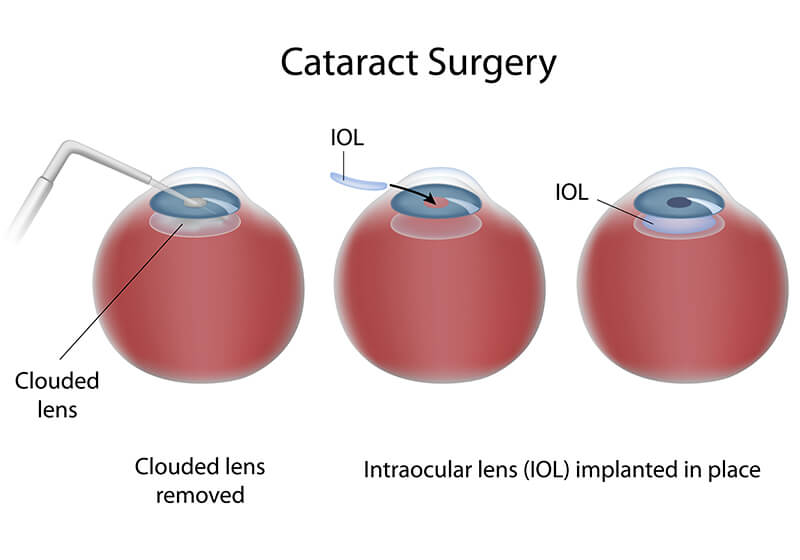
Femto-laser-assisted cataract surgery (FLACS), mentioned above, the most advanced form of cataract surgery available, is an option for patients. This laser technology results in a highly precise procedure with a very low risk of complications after surgery.
What intraocular lens (IOL) options are there?
Traditionally, the only intraocular lenses available to cataract patients were “monofocal”. This type of lens corrects unaided vision at only one point, either distance or near, depending on the power of the implant. Most of the time, an implant power is selected to completely correct a patient’s distance vision so that after the procedure, the patient will only need reading glasses.
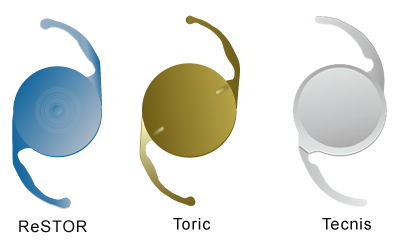
As a result of new technologies, new multifocal lenses such as the PanOptix, Vivity, ReSTOR, and Tecnis Symfony can now improve and broaden a patient’s vision, including distance, intermediate and near vision. Other lenses such as the AcrySof Toric lens can reduce astigmatism.
Prior to cataract surgery, we will discuss with you the various lens options to help make an informed decision. In addition, we will discuss the possible side effects; risks, benefits, and alternatives; and important pre and post-operative instructions. We will also review the insurance plans accepted by NY Vision Group and alternate financing options.
Whether you choose monofocal or multifocal lenses, there are risks and possible complications of cataract surgery. While rare and usually minor, they could permanently affect your vision. Complications include the worsening of your vision, bleeding, or infection. It is essential that patients follow their pre- and post-operative instructions and contact us if any unusual symptoms occur.
What is the recovery time for cataract surgery?
Cataract surgery is performed on an out-patient basis and the procedure typically takes less than 10 minutes. Patients can see immediately after the procedure, but the final visual result will take a few days. Wearing sunglasses for the first 24 hours to protect against foreign objects, dust, water is important, and you will also be given a prescription for special eye drops to help heal the eye and prevent infection.
Cataract Surgeon
At NY Vision Group, cataract surgery is primarily performed by Dr. Harry Koster. Dr. Koster is a board-certified ophthalmologist and cataract specialist. Dr. Koster has over 30 years of experience as a cataract surgeon in New York, in addition to his renowned experience in laser vision correction. A pioneer of cutting-edge medical technology, Dr. Koster was one of the first doctors to offer multifocal lenses to candidates for cataract surgery in the New York City area. More recently, he was the first NYC eye surgeon to perform laser-assisted cataract surgery with the two main platforms: the LenSx and Catalys. Additionally, he was the first surgeon in NYC to implant the PanOptix and Vivity lenses, an honor and a testament to his dedication and skill in the ophthalmic field.
NY Vision Group’s surgeons perform cataract surgery at NY Vision Group outpatient facilities in Manhattan, Brooklyn, and Queens. Book online for a consultation or call (212) 243-2300 to speak with a surgical coordinator today.

